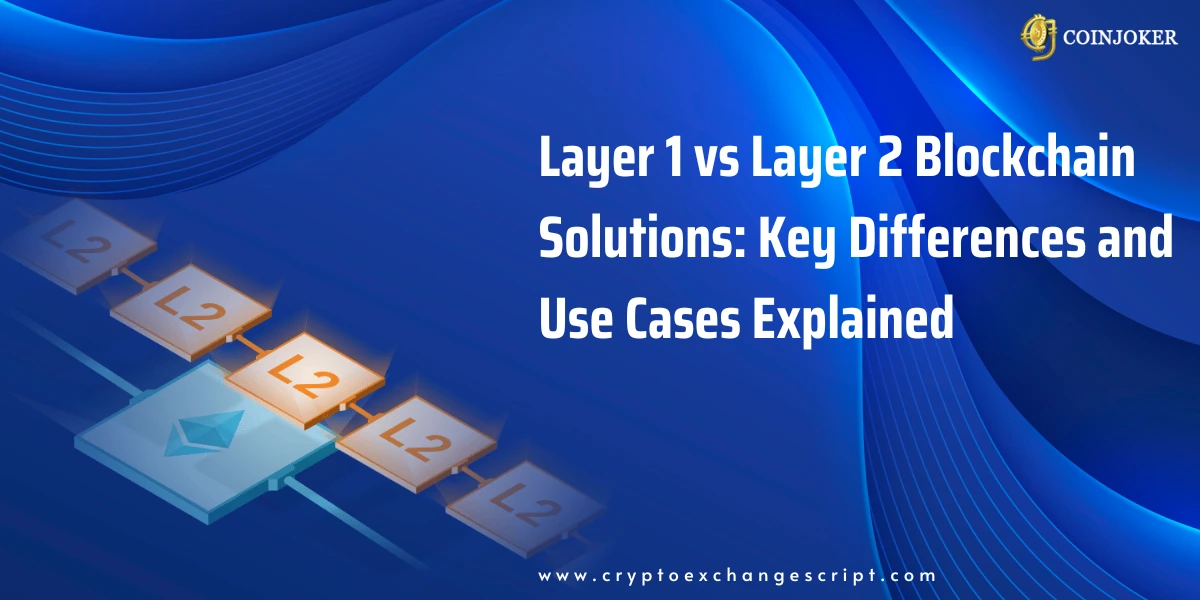Blockchain technology is transforming industries across the globe with its promise of decentralization, transparency, and security. However, as the adoption of blockchain increases, so does the need for scalability and performance. This is where Layer 1 and Layer 2 blockchain solutions come into play. These layers represent two different approaches to enhancing the blockchain ecosystem, particularly in terms of speed, scalability, and transaction costs.
In this blog, we’ll break down the core differences between Layer 1 and Layer 2 solutions, how they work, and the use cases where each shines the brightest.
What is a Layer 1 Blockchain?
Layer 1 refers to the base layer or the main blockchain architecture. It is the foundation on which the entire network is built and operates independently. Examples include Bitcoin, Ethereum, Solana, and Cardano.
Key Characteristics of Layer 1
Independent Consensus Mechanism: Each Layer 1 chain has its own rules for consensus (e.g., Proof of Work or Proof of Stake).
Native Token: These blockchains use their own native cryptocurrency (e.g., BTC for Bitcoin, ETH for Ethereum).
Smart Contracts (in some): Blockchains like Ethereum allow developers to build decentralized applications (dApps) on top of the Layer 1 chain.
Limitations of Layer 1
While secure and decentralized, Layer 1 blockchains often struggle with scalability. As more users and applications join, networks like Ethereum face high gas fees and slower transaction speeds. This has sparked the need for Layer 2 innovations.
What is a Layer 2 Blockchain?
Layer 2 refers to protocols that operate on top of a Layer 1 blockchain to improve its functionality, primarily speed and scalability. Rather than modifying the base layer, Layer 2 offloads some of the transactional work and later settles the results back on the Layer 1 chain.
Key Characteristics of Layer 2
Built on Top of Layer 1: They rely on Layer 1 for security but handle transactions off-chain.
Lower Transaction Fees: By batching or compressing transactions, Layer 2 reduces gas costs.
Faster Transactions: These solutions process transactions more quickly by avoiding Layer 1 congestion.
How Layer 1 Solutions Scale
Layer 1 blockchains can scale by modifying the core protocol itself. This includes:
Consensus Algorithm Upgrades: For example, Ethereum moved from Proof of Work (PoW) to Proof of Stake (PoS) to enhance scalability and reduce energy consumption.
Sharding: A method of splitting the blockchain into multiple “shards” to process transactions in parallel.
These upgrades are complex and may require hard forks, making them slower to implement.
How Layer 2 Solutions Scale
Layer 2 aims to enhance Layer 1 performance without altering the base protocol. Common types of Layer 2 scaling solutions include:
1. State Channels
These allow users to conduct multiple transactions off-chain and only settle the final state on the blockchain. Example: Bitcoin’s Lightning Network.
2. Plasma
A framework for creating child blockchains that interact with the main Ethereum chain. Each plasma chain can run its smart contracts and manage transactions.
3. Rollups
Rollups execute transactions off-chain and post the data to Layer 1. They come in two types:
- Optimistic Rollups (e.g., Optimism, Arbitrum)
- Zero-Knowledge Rollups (e.g., zkSync)
Use Cases for Layer 1 and Layer 2
Layer 1 Use Cases
- Store of Value: Bitcoin is primarily used as a decentralized store of value.
- Smart Contract Deployment: Ethereum and Solana enable dApp development and DeFi protocols.
- Native Token Transfers: High-security and low-level operations take place directly on Layer 1.
Layer 2 Use Cases
- Micropayments: Lightning Network enables near-instant microtransactions on Bitcoin.
- Gaming and NFTs: Projects like Immutable X use Layer 2 to power fast and cheap NFT trading.
- DeFi at Scale: Arbitrum and Polygon are popular for running scalable DeFi applications.
Why Both Layers Are Essential
It’s not a matter of Layer 1 versus Layer 2, but rather how both layers complement each other.
Think of Layer 1 as the secure foundation of a skyscraper and Layer 2 as the high-speed elevator that makes accessing various floors efficient and seamless.
While Layer 1 focuses on trustless decentralization and data integrity, Layer 2 focuses on usability and scalability. This two-layered approach allows the blockchain ecosystem to evolve in a way that supports massive adoption without sacrificing the core principles of decentralization.
Ethereum’s roadmap, for example, heavily incorporates both Layer 1 upgrades (like sharding) and Layer 2 scaling solutions to meet future demand. This collaborative strategy is expected to resolve the blockchain trilemma of security, decentralization, and scalability.
Expert Insight
Grasping the difference between Layer 1 and Layer 2 blockchain solutions is key to making smarter decisions in the decentralized space. While Layer 1 ensures the core security and decentralization of the network, Layer 2 enhances performance by offering faster, low-cost transactions, together forming a powerful and scalable blockchain ecosystem.
As the blockchain world evolves, businesses and developers must align with the right solution based on their goals and user demands. For those aiming to build robust blockchain platforms that blend scalability, security, and user-friendly experiences, partnering with the right Blockchain development company is critical.
Coinjoker, a pioneer in blockchain development, delivers tailored solutions across both Layer 1 and Layer 2 technologies. With a strong track record in creating next-gen decentralized platforms, Coinjoker empowers businesses to stay ahead in the competitive blockchain landscape.
Trending Blogs

Blockchain
Layer 1 vs Layer 2 Blockchain Solutions: Key Differences and Use Cases Explained
Blockchain technology is transforming industries across the globe with its promise of decentralizati ...

Blockchain
Layer 2 Solutions: Scaling the Blockchain for the Future
As blockchain adoption accelerates across industries, one of the most pressing challenges has become ...

AI
Revolutionizing Business Operations Through AI Automation
In the generation of digital transformation, businesses are constantly searching for approaches to s ...

AI
AI Analytics: Powering Smarter Decisions in a Data-Driven World
In today's data-driven world, organizations are increasingly turning to Artificial Intelligence (AI) ...

AR/VR
Virtual Reality Training: Transforming Workforce Development Through Immersive Learning
In today's rapidly evolving technological landscape, Virtual Reality (VR) training has emerged as a ...

Blockchain
Central Bank Digital Currencies (CBDCs) and Blockchain: Transforming the Future of Money
The financial landscape is undergoing a revolutionary shift with the rise of Central Bank Digital Cu ...

AI
AIOps: Revolutionizing IT Operations with Artificial Intelligence
In today's digital age, businesses are increasingly reliant on IT infrastructure to ensure seamless ...

AI
Quantum Computing: The Future of High-Performance Computing
Quantum computing is no longer just a futuristic concept—it’s becoming a real force of change in ...

Cryptocurrency Exchange
Mastering Crypto Trading Strategies: A Guide for Traders
Cryptocurrency trading has revolutionized financial markets, offering traders lucrative opportunitie ...

AR/VR
Virtual Reality and AI in Healthcare: The Next Big Leap in Medical Consultations
Explore how Virtual Reality and AI are transforming healthcare, revolutionizing medical consultation ...
